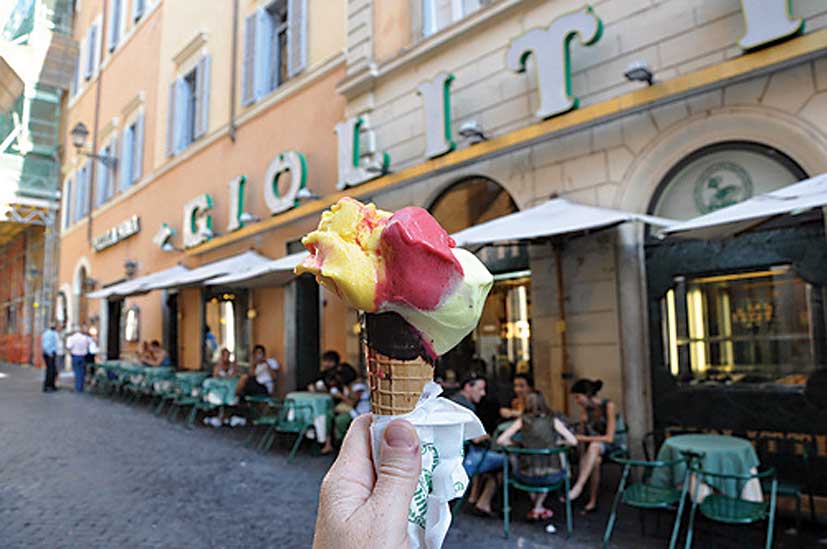Like pizza (covered in our January 2015 issue), pasta, espresso coffee, and gelato are quintessential Italian foods. Gelato is the Italian word for ice cream, derived from the Latin word gelatus, meaning frozen. Gelato can be made with milk, cream, various sugars and flavorings such as fresh fruit and nut purees. It is generally lower in calories, fat, and sugar than ice cream.
The history of gelato is not well documented. Some say that it dates back to an anonymous genius, who, during the reign of ancient Roman Emperor Nero (54-68 AD), poured fruit juice over snow, then preserved underground, and ate it. The difficulty of obtaining snow and maintaining it meant that only the privileged could enjoy this proto-sherbet, which disappeared with the fall of the Roman Empire.
Around that time — 400 A.D. — according to Wikipedia, “Arabs used milk as a major ingredient of ice cream production and sweetened it with sugar rather than fruit juices. It was flavored with rosewater, dried fruits, and nuts.”
It was not until the 13th century that anything similar to gelato was known again in the West. Marco Polo brought back a recipe similar to the Roman one with the addition of milk.
According to legend, when Catherine de’ Medici married the Duke of Orléans (later King Henry II of France) in 1553, she is said to have brought with her to France some Italian chefs who had recipes for flavored ices or sorbets. About 100 years later, Charles I of England was so impressed by “frozen snow” that he offered his ice cream maker a lifetime pension in return for keeping his formula secret so that ice cream could be a royal prerogative.
Formerly a fisherman, Sicilian-born Procopio Cutò, sometimes referred to as “the Father of Italian gelato,” was another Italian who brought gelato to France.
Before leaving Sicily he perfected the first ice cream machine, his grandfather’s invention, and upon his arrival in Paris in the early 1670s he worked as an apprentice at a lemonade and coffee kiosk, which he bought in 1675.
He went on to found, in 1686, the first literary coffeehouse in Paris, the oldest extant café in the “City of Lights,” Café Procope, across the street from the Comédie-Française. Here he was one of the first to sell this new “European” product — previously reserved for royalty only — directly to the public.
Farther afield, Quaker colonists introduced ice cream to the United States. Benjamin Franklin, George Washington, and Thomas Jefferson were known to have regularly eaten and served ice cream. First Lady Dolly Madison, wife of President James Madison, served ice cream at her husband’s Inaugural Ball in 1813.
In spite of gelato’s popularity worldwide, Italy is the only country where the market share of handmade gelato versus the industrial one is more than 55%. Today, some 40,000 modern Italian ice cream parlors employ more than 150,000 people, mostly Italians.
If you would like to learn how to become a professional gelato artisan and run your own gelateria, you may enroll at Carpigiani Gelato University in Anzola dell’Emilia, near Bologna in central Italy. Set up by ice cream machine and equipment maker Carpigiani in 2003, its most popular course, “Becoming a gelataio,” lasts four weeks, is available taught in Italian, English, French, and German, and costs c. 1,300 euros (board not included).
In Rome, the neighborhood around the Pantheon has the highest concentration of top artisan gelaterie: Fiocco di Neve (Via del Pantheon 51, best flavor: eggnog), Della Palma (2013 TripAdvisor Certificate of Excellence, 150 flavors), San Crispino (white peach and meringue), and Grom (the latter three all on Via Maddalena), Ciampini (outdoor seating, Piazza San Lorenzo in Lucina 24, chestnut) and Giolitti (most famous ice cream parlor in Rome, maybe in Italy, outdoor and indoor seating, Via Uffizi del Vicario 40, open 365 days a year since 1890, 7-1:30 AM, 100 flavors, all tops).
Near St. Peter’s: V-Ice (5th bus stop [nos. 98, 881, 916] uphill at Via Gregorio VII 385 or downtown, branch on Corso Vittorio Emanuele II, pistachio); Cremeria Aurelia (5th stop [no. 46] uphill at Via Aurelia 398, all seasonal fruits and spices); Gelateria dei Gracchi, (Via dei Gracchi 272, almond all’orange, chocolate with rum), Gelateria Old Bridge (Via Bastioni di Michelangelo 5, near Vatican Museums, 2014 TripAdvisor Certificate of Excellence, almond); Hedera (Borgo Pio 179, 2015 TripAdvisor Certificate of Excellence, hazelnut, pistachio, and licorice).







Facebook Comments